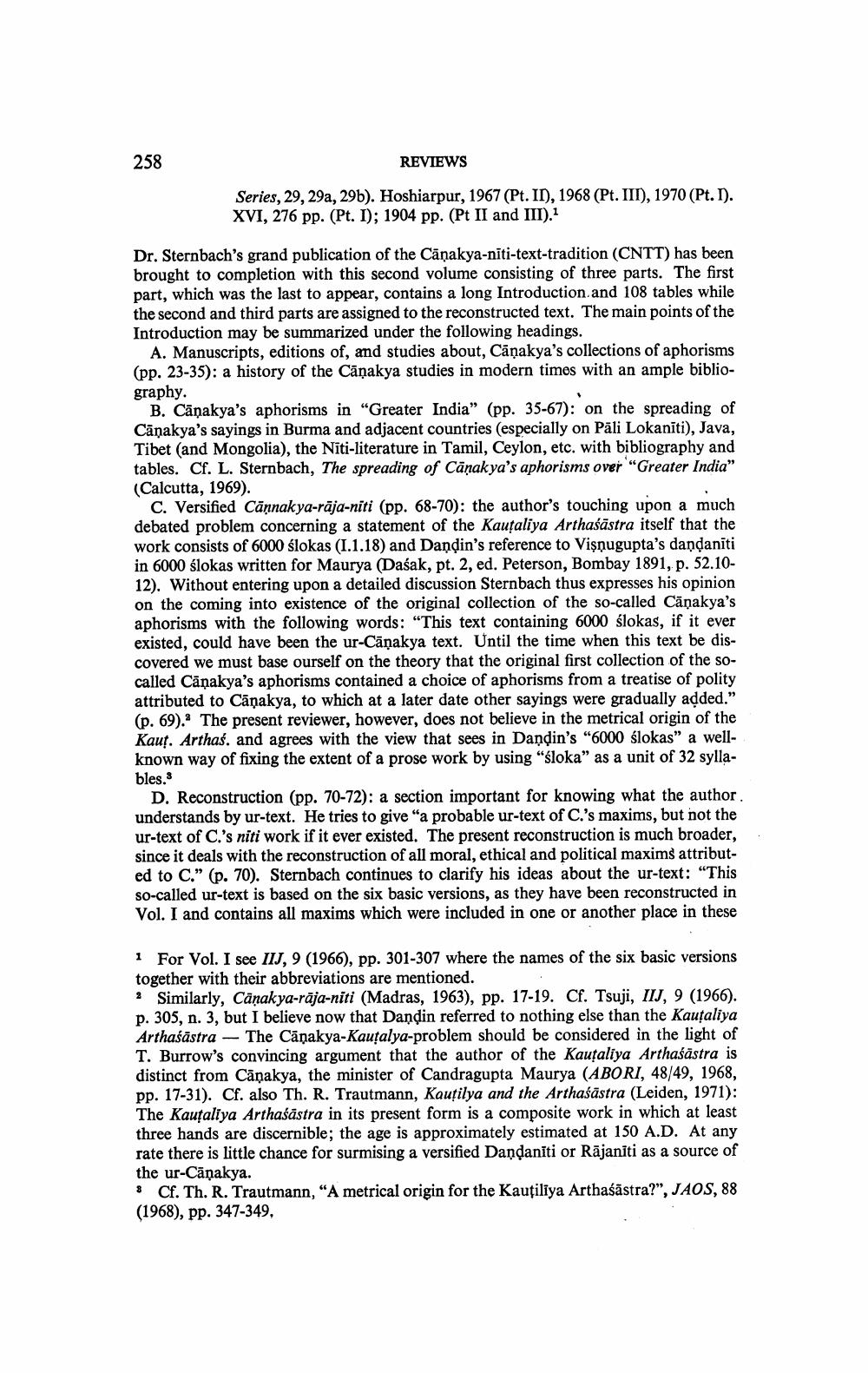________________ 258 REVIEWS Series, 29, 29a, 29b). Hoshiarpur, 1967 (Pt. II), 1968 (Pt. III), 1970 (Pt. I). XVI, 276 pp. (Pt. I); 1904 pp. (Pt II and III).1 Dr. Sternbach's grand publication of the Canakya-niti-text-tradition (CNTT) has been brought to completion with this second volume consisting of three parts. The first part, which was the last to appear, contains a long Introduction and 108 tables while the second and third parts are assigned to the reconstructed text. The main points of the Introduction may be summarized under the following headings. A. Manuscripts, editions of, and studies about, Canakya's collections of aphorisms (pp. 23-35): a history of the Canakya studies in modern times with an ample bibliography. B. Canakya's aphorisms in "Greater India" (pp. 35-67): on the spreading of Canakya's sayings in Burma and adjacent countries (especially on Pali Lokaniti), Java, Tibet (and Mongolia), the Niti-literature in Tamil, Ceylon, etc. with bibliography and tables. Cf. L. Sternbach, The spreading of Canakya's aphorisms over "Greater India" (Calcutta, 1969). C. Versified Cannakya-raja-niti (pp. 68-70): the author's touching upon a much debated problem concerning a statement of the Kautaliya Arthasastra itself that the work consists of 6000 slokas (I.1.18) and Dandin's reference to Visnugupta's dandaniti in 6000 slokas written for Maurya (Dasak, pt. 2, ed. Peterson, Bombay 1891, p. 52.1012). Without entering upon a detailed discussion Sternbach thus expresses his opinion on the coming into existence of the original collection of the so-called Canakya's aphorisms with the following words: "This text containing 6000 slokas, if it ever existed, could have been the ur-Canakya text. Until the time when this text be discovered we must base ourself on the theory that the original first collection of the socalled Canakya's aphorisms contained a choice of aphorisms from a treatise of polity attributed to Canakya, to which at a later date other sayings were gradually added." (p. 69). The present reviewer, however, does not believe in the metrical origin of the Kauf. Arthas. and agrees with the view that sees in Dandin's "6000 slokas" a wellknown way of fixing the extent of a prose work by using "sloka" as a unit of 32 syllables. D. Reconstruction (pp. 70-72): a section important for knowing what the author understands by ur-text. He tries to give "a probable ur-text of C.'s maxims, but not the ur-text of C.'s niti work if it ever existed. The present reconstruction is much broader, since it deals with the reconstruction of all moral, ethical and political maxims attributed to C." (p. 70). Sternbach continues to clarify his ideas about the ur-text: "This so-called ur-text is based on the six basic versions, as they have been reconstructed in Vol. I and contains all maxims which were included in one or another place in these 1 For Vol. I see IIJ, 9 (1966), pp. 301-307 where the names of the six basic versions together with their abbreviations are mentioned 2 Similarly, Canakya-raja-niti (Madras, 1963), pp. 17-19. Cf. Tsuji, IIJ, 9 (1966). p. 305, n. 3, but I believe now that Dandin referred to nothing else than the Kausaliya Arthasastra - The Canakya-Kausalya-problem should be considered in the light of T. Burrow's convincing argument that the author of the Kautaliya Arthasastra is distinct from Canakya, the minister of Candragupta Maurya (ABORI, 48/49, 1968, pp. 17-31). Cf. also Th. R. Trautmann, Kautilya and the Arthasastra (Leiden, 1971): The Kautaliya Arthasastra in its present form is a composite work in which at least three hands are discernible; the age is approximately estimated at 150 A.D. At any rate there is little chance for surmising a versified Dandaniti or Rajaniti as a source of the ur-Canakya. 8 Cf. Th. R. Trautmann, "A metrical origin for the Kautiliya Arthasastra?", JAOS, 88 (1968), pp. 347-349,




